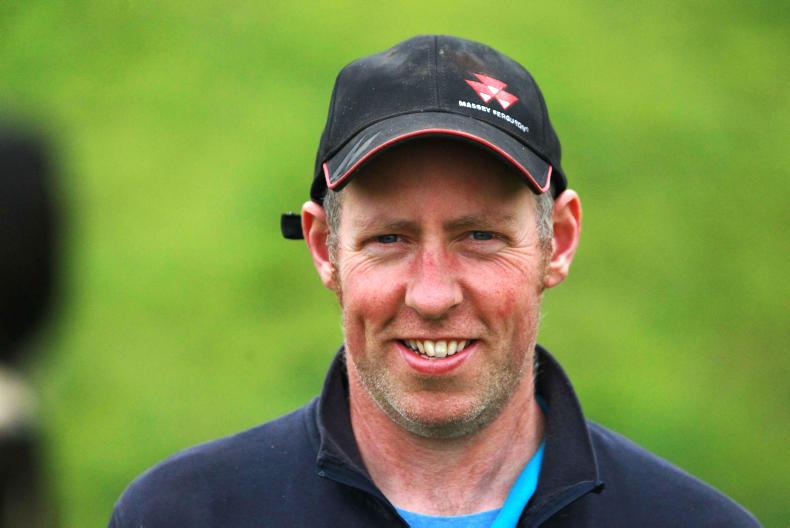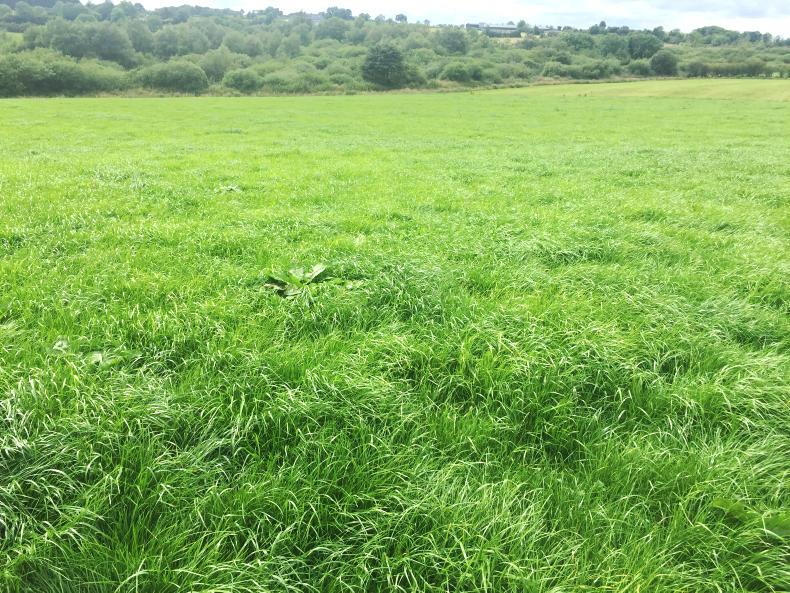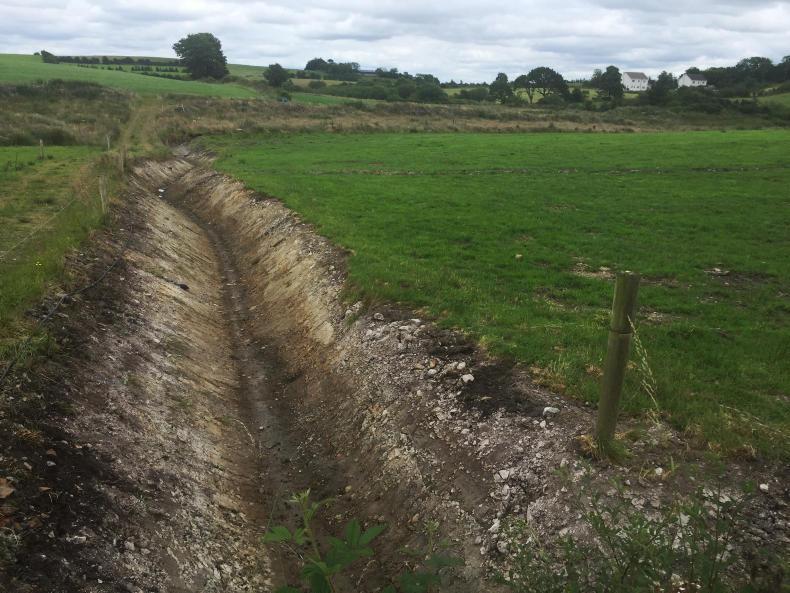David Brady’s farm near Stradone in Cavan isn’t a simple one. There are a total of 47 fields in the 100 acre milking block.
These paddocks aren’t split by a wire, and in nearly all cases there are hedgerows and open drains splitting fields.
In comparison to farms in other parts of the country, it makes grazing and grassland management much more difficult.

Dairylink farmer David Brady, Tierlahhood, Stradone, Co Cavan. \ Jack Caffrey
But David isn’t overly phased by it. He walks the farm every four or five days and puts the grass figures into PastureBase.
So far this year, he has over 7t/ha of grass grown on the 40.47ha milking block and has over 25 grass walks completed. Most people who measure grass would scarcely do that in the full year.
Farm management
There’s a shed with large maps of the farm up on three large whiteboards. There’s one map for soil pH, one map for phosphorus and one map for potash.

David got maps of the farm blown up on whiteboards at a cost of €500
The soil index for each paddock is written with coloured marker. The low index fields are clearly identified so they get extra treatment.
When David started in the Dairylink project, he didn’t know exactly how many acres were in each field, but now he can measure and manage with a lot more accuracy.
“The small paddock size is a bit of an issue, as it’s very hard to get the grazings accurate.
"For example, the cows should have got one full grazing in a field the other night, but they ended up leaving a lot of grass behind them as they weren’t hungry.
"That residual was just left there, whereas I would prefer if it was grazed out, but that’s what happens” David says.
At the moment he is busy taking out paddocks for silage, as grass is consistently getting ahead of the cows. Apart from two days in early June when it rained over 75mm, it’s been a great summer.
David has 210 bales made and carried over 80 from last year. He cut the first cut on 15 May and he did the second cut on 3 July.

A field that was skipped over for silage
Cows are milking well at 21.5l at 3.9% fat and 3.43% protein or 1.62kg of milk solids. The cows are on 1kg of meal each, and he doesn’t plan to feed more than that per day for the next six weeks.
David has sold 230kg of milk solids per cow up to 26 June, from a total of 400kg of meal fed to date.
He expects the cows to produce 450kg of milk solids this year, with meal feeding levels in or around the 700 to 800kg per cow mark.
As he says himself, it all depends on the weather. Soil type is heavy and the farm is in a high rainfall area, so he is very much exposed to the weather.
Development
David is currently milking 103 cows on the 40.47ha milking platform, but is farming a total of 69 hectares.
There are around 25 heifers of each age group on the farm. He has 12 cows on the farm that he hasn’t bred because they are old, have a history of mastitis or have poor milk yield. The plan is to milk a similar number of cows next year.
The Brady farm has undergone serious development over the last few years. Soil fertility is more or less sorted with the numbers of fields requiring attention now minimal.
A serious amount of reseeding has been completed, with more to be done. Thirteen acres have been reseeded so far this year, and another five acres are going to be drained and mole-ploughed next week to prepare for reseeding.

This field is set to be mole ploughed next week
David bought 14 acres of the milking platform last winter. He was already leasing the land, and it too has been drained and reseeded.
According to David’s 2018 dairy Profit Monitor, net profit including direct payments was 14c/l. This figure is different to the cash surplus however, as David and his father’s own labour, debt repayments and taxation are not included.
Read more
Dairylink Ireland: planning for parlour development in Cavan
Planning cashflow as margins tighten
David Brady’s farm near Stradone in Cavan isn’t a simple one. There are a total of 47 fields in the 100 acre milking block.
These paddocks aren’t split by a wire, and in nearly all cases there are hedgerows and open drains splitting fields.
In comparison to farms in other parts of the country, it makes grazing and grassland management much more difficult.

Dairylink farmer David Brady, Tierlahhood, Stradone, Co Cavan. \ Jack Caffrey
But David isn’t overly phased by it. He walks the farm every four or five days and puts the grass figures into PastureBase.
So far this year, he has over 7t/ha of grass grown on the 40.47ha milking block and has over 25 grass walks completed. Most people who measure grass would scarcely do that in the full year.
Farm management
There’s a shed with large maps of the farm up on three large whiteboards. There’s one map for soil pH, one map for phosphorus and one map for potash.

David got maps of the farm blown up on whiteboards at a cost of €500
The soil index for each paddock is written with coloured marker. The low index fields are clearly identified so they get extra treatment.
When David started in the Dairylink project, he didn’t know exactly how many acres were in each field, but now he can measure and manage with a lot more accuracy.
“The small paddock size is a bit of an issue, as it’s very hard to get the grazings accurate.
"For example, the cows should have got one full grazing in a field the other night, but they ended up leaving a lot of grass behind them as they weren’t hungry.
"That residual was just left there, whereas I would prefer if it was grazed out, but that’s what happens” David says.
At the moment he is busy taking out paddocks for silage, as grass is consistently getting ahead of the cows. Apart from two days in early June when it rained over 75mm, it’s been a great summer.
David has 210 bales made and carried over 80 from last year. He cut the first cut on 15 May and he did the second cut on 3 July.

A field that was skipped over for silage
Cows are milking well at 21.5l at 3.9% fat and 3.43% protein or 1.62kg of milk solids. The cows are on 1kg of meal each, and he doesn’t plan to feed more than that per day for the next six weeks.
David has sold 230kg of milk solids per cow up to 26 June, from a total of 400kg of meal fed to date.
He expects the cows to produce 450kg of milk solids this year, with meal feeding levels in or around the 700 to 800kg per cow mark.
As he says himself, it all depends on the weather. Soil type is heavy and the farm is in a high rainfall area, so he is very much exposed to the weather.
Development
David is currently milking 103 cows on the 40.47ha milking platform, but is farming a total of 69 hectares.
There are around 25 heifers of each age group on the farm. He has 12 cows on the farm that he hasn’t bred because they are old, have a history of mastitis or have poor milk yield. The plan is to milk a similar number of cows next year.
The Brady farm has undergone serious development over the last few years. Soil fertility is more or less sorted with the numbers of fields requiring attention now minimal.
A serious amount of reseeding has been completed, with more to be done. Thirteen acres have been reseeded so far this year, and another five acres are going to be drained and mole-ploughed next week to prepare for reseeding.

This field is set to be mole ploughed next week
David bought 14 acres of the milking platform last winter. He was already leasing the land, and it too has been drained and reseeded.
According to David’s 2018 dairy Profit Monitor, net profit including direct payments was 14c/l. This figure is different to the cash surplus however, as David and his father’s own labour, debt repayments and taxation are not included.
Read more
Dairylink Ireland: planning for parlour development in Cavan
Planning cashflow as margins tighten










 This is a subscriber-only article
This is a subscriber-only article









SHARING OPTIONS: